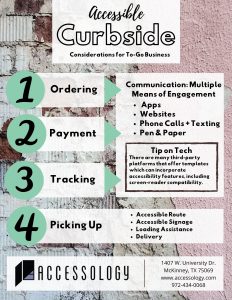The novel coronavirus has been a marathon test of human ingenuity. The year-plus since the emergence of COVID-19 has seen an unprecedented shift in the economic balance of communities world-wide and companies have broken the mold of traditional business models as they adapt to public health orders, as well as the needs of customers wishing to dodge long periods of exposure to others. Changes aren’t strictly health-related either. While shutdowns and stay-at-home orders have largely subsided since their initial mandates in early 2020, the commercial impact remains; 22% loss in revenue that could trend as high as $4.8 trillion in net losses over the next two years, according to a study by the University of Southern California. For many, the solution to this issue has been the provision of curbside pick-up, in which customers can order products to-go, arrive at the store, receive their items, and return home. The retail stagnation ushered in by coronavirus saw the availability of curbside pick-up increase 208% within one month of economic restrictions, and with still-increasing implementation, it is expected to stay. What was once a matter of convenience has become an act of survival for both customers and businesses alike; a beacon of stability that is steadily solidifying itself as a standard practice.
While certainly safer as COVID-19 cases toll into the millions, curbside service also offers several unique benefits for disabled individuals that extend beyond pandemic-life problems. For the most part, curbside and to-go ordering has always made goods more accessible to people with disabilities, though historically reserved for larger businesses. Curbside service allows someone to avoid sparse parking, inaccessible entrances, unbearably long walks through winding aisles, and other exhausting aspects of public appearances. It often compensates for many of the barriers that businesses have not yet removed. Beyond being a valuable strategy for mediating barriers according to Title III of the Americans with Disabilities Act (ADA), curbside service taps into the economic power of the disabled community which many neglect when considering market demographics. According to a 2018 study by the American Institute of Research, working-age people with disabilities contribute about $490 billion in disposable income and $21 billion in discretionary income to the economy — a sum not to be overlooked in the era of COVID-19. Among the settling dust of whirlwind rollouts though, several issues in accessibility are rising that have many businesses curbing their enthusiasm when it comes to curbside services.
 One of the foremost obstacles that many businesses have when offering curbside service involves understanding the obligation to remove barriers under the Americans with Disabilities Act, as well as how barriers might emerge in a particular situation. Regardless of company size, goods or services provided, building lease, or global contagion, businesses may not discriminate against patrons with disabilities, the first step of which involves recognizing the responsibility that businesses have to provide access to goods and services. This includes amenities like curbside service. For curbside service, the areas most often associated with accessibility involve physical access and effective communication. Consider the stages that someone may go through when engaging business for curbside pick-up. The first step in a purchase is likely communicating which goods a customer has selected. Followed by paying for the order, tracking the order, and physically accessing the order, each step has varying degrees of communication between. How might these steps change for people experiencing different disabilities? Someone using a wheelchair may have completely different barriers from someone who is blind of course, and accounting for a variety of backgrounds not only protects a business from legal repercussions, but also diversifies an establishment’s consumer base.
One of the foremost obstacles that many businesses have when offering curbside service involves understanding the obligation to remove barriers under the Americans with Disabilities Act, as well as how barriers might emerge in a particular situation. Regardless of company size, goods or services provided, building lease, or global contagion, businesses may not discriminate against patrons with disabilities, the first step of which involves recognizing the responsibility that businesses have to provide access to goods and services. This includes amenities like curbside service. For curbside service, the areas most often associated with accessibility involve physical access and effective communication. Consider the stages that someone may go through when engaging business for curbside pick-up. The first step in a purchase is likely communicating which goods a customer has selected. Followed by paying for the order, tracking the order, and physically accessing the order, each step has varying degrees of communication between. How might these steps change for people experiencing different disabilities? Someone using a wheelchair may have completely different barriers from someone who is blind of course, and accounting for a variety of backgrounds not only protects a business from legal repercussions, but also diversifies an establishment’s consumer base.
Communication barriers are common for blind individuals, deaf individuals, people with learning disorders such as dyslexia, and speech-related disabilities and inhibit the most fundamental steps of commerce. One of the advantages of life in the 21st century is readily-available technology that allows businesses to centralize a large part of the to-go process through a single platform, such as an app or a website. Provided that those platforms are accessible under WCAG 2.0, consumers can select products, pay for their order, and track their purchase in one place. Many websites and applications even send order updates, and allow in-app encrypted messaging or other forms of contact. More so, many templates allow the incorporation of many standard accessibility features which allows even the layperson to create and manage these sources. Removing barriers in communication can take even low-tech forms, though. Simpler solutions like allowing text messaging alongside phone calls or providing a pen and paper can help businesses accommodate a variety of disabilities at low cost and even lower training. Additionally, while temporary signs are not required to comply with the 2010 ADA Standards, signage is an often-overlooked component of effective communication that shapes the experience of curbside pick-up. Pick-up zones should be clearly designated with accessible characteristics in mind: bold sans-serif lettering with high contrast, limited decorative elements, and mounting at an appropriate height to communicate information regarding the pick-up process.
The second aspect of curbside pick-up involves the physical barriers that people with disabilities, particularly those who use wheelchairs or other mobility devices, might experience when picking up their orders. Not unlike pre-pandemic shopping, location is often the first barrier encountered, which isn’t necessarily relevant to businesses who ask customers to remain in their vehicles. Many businesses are choosing to allow pick-up at their entrance or outside the building, in which case pick-up locations should be placed on an accessible route within a reasonable distance from accessible parking. Remember: accessible parking spaces cannot be redesignated for curbside pick-up. Accessible parking must remain available as part of an accessible route, and fines may be imposed on those who redesignate spaces. Features of an accessible route also include a clear path of travel along a firm, even surface such as concrete, rather than gravel, grass, or high-pile carpet, and may include a ramp or curb-cut if needed. Pick-up zones within buildings have many of these same obligations, though are more likely to have been previously implemented in an establishment’s pre-pandemic service process. If a pick-up location cannot be made accessible, delivery can be offered as a reasonable modification.
Modification is a key tenet in all adaptation after all. Whether fighting through the tediousness of weekly errands or waging a viral battle on a cellular level, adaptation is the backbone of mankind’s perseverance. Disabled and nondisabled consumers are reaching for modes that keep us tethered to the comforts and commodities required to thrive, and curbside service is meeting their grasp. It’s a convenience, a necessity, and a success, perfectly packaged and ready for pick-up in an age that seems to continually distance us from the parts of our life that seem familiar and perfectly domestic. The commitment to accessibility is a commitment to connection, and ensuring curbside pick-up is accessible connects businesses and communities at a time when it’s needed most.





